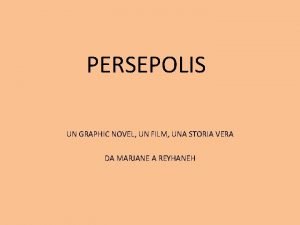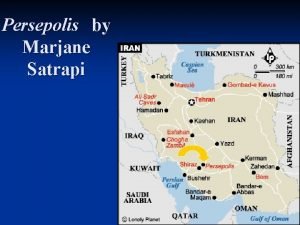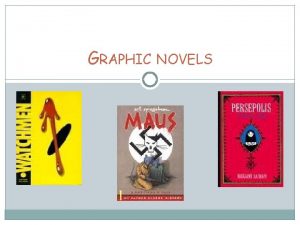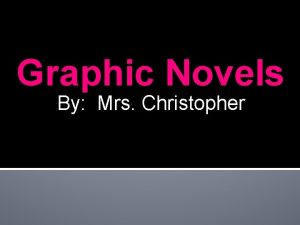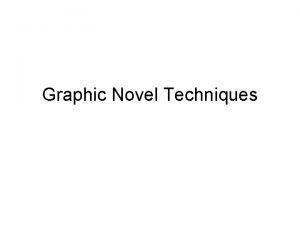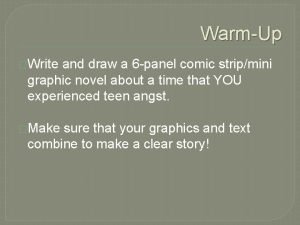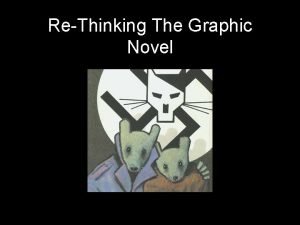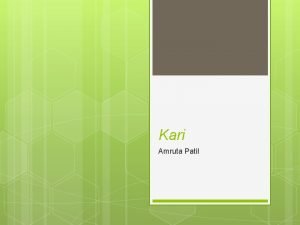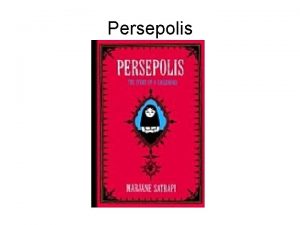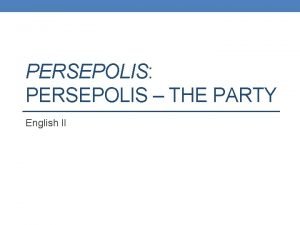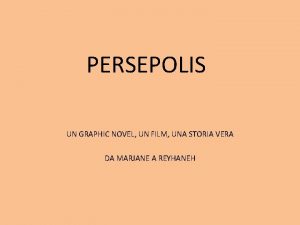PERSEPOLIS A Graphic Novel GRAPHIC ART TERMS v









- Slides: 9

PERSEPOLIS A Graphic Novel

GRAPHIC ART TERMS v. Panel: A distinct segment of the comic that contains a combination of image and text in endless variety. v. Frame: The lines and borders that contain the panels. v. Gutter: The space between framed panels. v. Bleed: An image that extends to and/or beyond the edge of the page. v. Foreground: The panel/image closest to the viewer. v. Midground: An image deliberately placed where the viewer will most likely look first. v. Background: Provides additional, subtextual information for the reader.

TERMS CONTINUED v. Graphic Weight: refers to the visual “weight” of an image. An image with graphic weight creates focus and draws the eye to it. v. Figures: Faces are used to express emotion and impact mood, while hands and feet give the reader information about action. v. Text: *Captions: boxes containing scene-setting, descriptions, background info, etc. *Speech Balloons: represent speech coming from a particular character’s mouth or thought coming from a character’s head. *Special Effects Lettering: a method of drawing attention to text; often highlights onomatopoeia.

PERSEPOLIS Reading Guide Activities

SKILL DRILLS Directions: For each vignette that you select, chose one skill to practice while answering one of the reading guide questions. • On the three following slides you will find five skills labeled 1 through 5 and ten questions labeled A through J. • You will use each skill twice and each question once. • Label your answers as follows: Vignette title Skill # Question letter

SKILL OPTIONS For each vignette that you read, select a skill to practice from the list below: 1. Use strong verbs not just “to be” verbs, and use specific detail. 2. Create strong sentence starters and transitions. DO NOT use “there are”/ “there is” or “I think”/”I believe”. 3. Write a response without using “you”, “good”, “bad”, “thing”, or other dead language. 4. Demonstrate the proper use of mechanics and grammar. Proof read your work! 5. Create sentences with varied sentence structure: simple, compound, complex, and compound-complex sentences must be used at least once each.

QUESTION OPTIONS Then chose one question per vignette to answer using your chosen skill. A. What was the author’s purpose in writing this story? How do you know? B. What new information stood out to you in this story? Why did it stand out? What was its effect? C. How would this story be different if told from a male view point? Explain why and how it might be different. D. How is the difference in class noted in this story? What is the effect of showing the variety of socio-economic status changes in the story? E. How would you describe Marji? To what extent is she similar to or different from you?

QUESSTIONS CONTINUED E. How important is family in Iranian society? How does this compare to the importance placed on the family in our society? F. Describe and evaluate the style of Satrapi’s drawings. How does this style contribute to the story that she tells? G. What are some of the key differences between the Iranian culture in which Marji was raised and Western culture? H. What are the strengths and limitations of using images to tell this story? Explain! I. What role does the educational system play in post-revolutionary Iran? J. How does Satrapi depict the roles of women in the story? What is her tone regarding these roles?

RUBRIC q. Each of the five skills has been demonstrated twice. 10 pts. q. Student has identified the best of each pair of attempts to be graded by placing a star next to them. These will be scored for accuracy. (4 pts. Each) 20 pts. q. Each of the ten questions has been answered. 10 pts. q. Responses were given in SAF format (claim, data, warrant, conclusion). 20 pts. q. The student has identified the best SAF response with a smiley face. This will be scored for accuracy. 40 pts. q. Total possible points = 100
